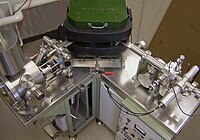
Comparing accretion disks and dark matter spikes in intermediate mass ratio inspirals
Sign Up to like & getrecommendations! Published in 2022 at "Physical Review D"
DOI: 10.1103/physrevd.107.083003
Abstract: Intermediate Mass Ratio Inspirals (IMRIs) will be observable with space-based gravitational wave detectors such as the Laser Interferometer Space Antenna (LISA). To this end, the environmental effects in such systems have to be modeled and… read more here.
Keywords: accretion; ratio inspirals; mass ratio; disks dark ... See more keywords

Science with the space-based interferometer LISA. V: Extreme mass-ratio inspirals
Sign Up to like & getrecommendations! Published in 2017 at "Physical Review D"
DOI: 10.1103/physrevd.95.103012
Abstract: The space-based Laser Interferometer Space Antenna (LISA) will be able to observe the gravitational-wave signals from systems comprised of a massive black hole and a stellar-mass compact object. These systems are known as extreme-mass-ratio inspirals… read more here.
Keywords: mass ratio; space; ratio inspirals; mass ... See more keywords

Extremely large mass-ratio inspirals
Sign Up to like & getrecommendations! Published in 2019 at "Physical Review D"
DOI: 10.1103/physrevd.99.123025
Abstract: The detection of the gravitational waves (GWs) emitted in the capture process of a compact object by a massive black hole (MBH) is known as an extreme-mass ratio inspiral (EMRI) and represents a unique probe… read more here.
Keywords: extremely large; ratio; mass ratio; mass ... See more keywords

Testing dispersion of gravitational waves from eccentric extreme-mass-ratio inspirals
Sign Up to like & getrecommendations! Published in 2019 at "International Journal of Modern Physics D"
DOI: 10.1142/s0218271819501669
Abstract: In general relativity, there is no dispersion in gravitational waves, while some modified gravity theories predict dispersion phenomena in the propagation of gravitational waves. In this paper, we demonstrate that this dispersion will induce an… read more here.
Keywords: dispersion; gravitational waves; mass ratio; mass ... See more keywords